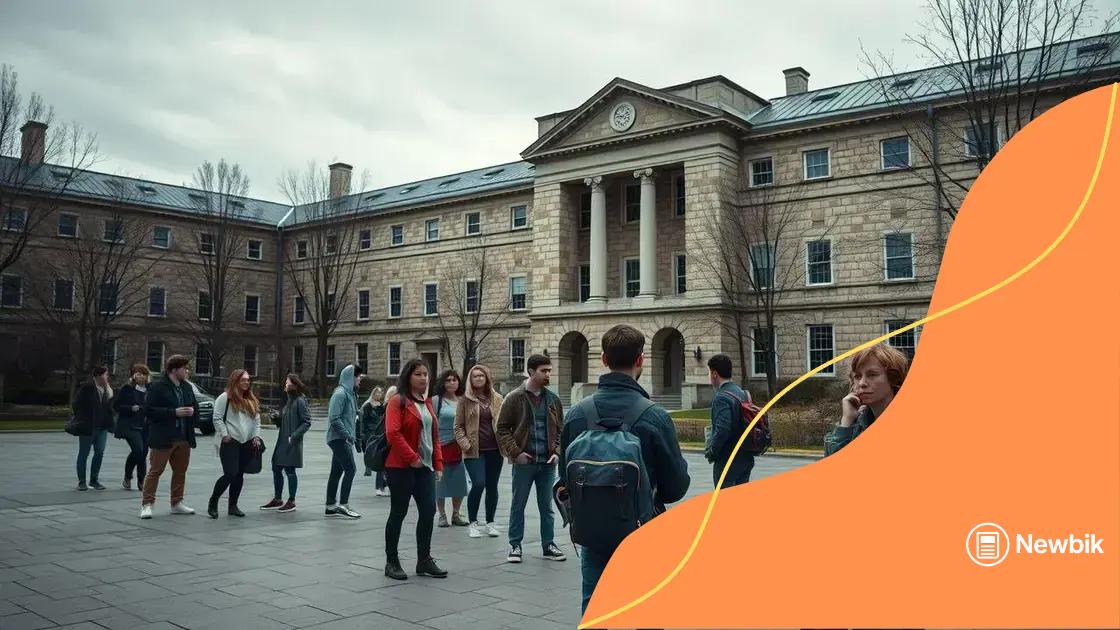Higher education funding challenges you need to know

Higher education funding challenges include rising tuition costs, funding cuts, and the need for alternative funding models like crowdfunding and income share agreements to ensure accessibility and quality in education.
Higher education funding challenges are becoming increasingly prominent, impacting students and institutions alike. Ever wonder how these financial hurdles affect your educational journey? Let’s dive into the intricacies of this critical issue.
Understanding the landscape of higher education funding
Understanding the landscape of higher education funding is crucial for students and institutions alike. It can determine the availability of resources and impact the overall educational experience.
Current Funding Sources
Funding often comes from various sources, and each plays a significant role. Recognizing these can help in navigating potential financial challenges. Some key sources include:
- State Government Allocations – These funds typically contribute significantly to public colleges and universities.
- Tuition Fees – This is a primary revenue source for many institutions, directly affecting accessibility.
- Federal Grants and Loans – Programs such as Pell Grants provide crucial support to low-income students.
- Endowments and Donations – Private contributions can greatly enhance funding opportunities.
Each source has its own implications. For instance, state funding can fluctuate based on budgetary constraints, which may affect tuition and resources. When state budgets are tight, public institutions often face cuts, which can lead to increased tuition fees for students.
Impact of Federal Policies
Federal policies also shape the funding landscape. Changes in legislation can affect how funds are distributed and what requirements students must meet. Understanding these policies helps navigate uncertainties in funding. For example, recent policy changes have made it easier for certain student demographics to access financial aid.
Students should also be aware of available scholarships. Many institutions offer merit-based and need-based scholarships to help cover costs. Exploring these options can provide valuable financial relief.
Moreover, the role of community colleges in the funding landscape is growing. These institutions often provide affordable educational options and pathways to four-year universities, making higher education more accessible.
In conclusion, understanding the landscape of higher education funding involves recognizing current sources, the impact of federal policies, and the opportunities provided by scholarships and community colleges. By staying informed, students can better navigate their financial options.
Main sources of funding for colleges and universities
The main sources of funding for colleges and universities play a vital role in shaping the educational landscape. Understanding these sources helps students and institutions navigate financial challenges effectively.
Government Funding
One of the largest contributors to education is government funding. This includes allocations from state and federal governments that support operations in public colleges and universities.
- State Allocations – States provide significant financial support, which can vary based on budget priorities.
- Federal Grants – These funds help universities offer scholarships and maintain programs.
- Local Funding – Some funding comes from local governments, often earmarked for community colleges.
Government funding can sometimes be unpredictable due to changing political climates. Institutions must adapt to these fluctuations to ensure their students receive adequate resources.
Tuition and Fees
Another primary source of funding is tuition fees. Students pay these fees to enroll and attend classes. This source is essential for maintaining operations and funding student services.
- In-State vs. Out-of-State Tuition – Many institutions charge different rates based on residency, impacting accessibility.
- Fee Structures – Additional fees for specific courses and activities can also contribute to revenue.
- Scholarships and Aid – Many students rely on scholarships to cover tuition costs, effectively reducing their financial burden.
As tuition rises, challenges emerge. Increased costs can lead to student debt, which affects enrollment and long-term success.
Endowments and Donations
Funding from endowments and private donations also plays a crucial role. Many universities have large endowments that provide ongoing financial support. These funds are usually invested, and the returns are used to support operations.
Alumni contributions are significant as well. Many alumni choose to give back after graduation, supporting future students. Fundraising campaigns also help generate additional revenue, allowing institutions to expand programs and improve facilities.
Furthermore, businesses often partner with universities, providing financial support in exchange for workforce development opportunities. These partnerships can lead to innovative programs benefiting both institutions and industries.
Impact of funding cuts on students and institutions

The impact of funding cuts on students and institutions can be profound. When funding is reduced, it often leads to challenges that affect the quality of education and the overall student experience.
Effects on Educational Quality
One significant consequence of funding cuts is the decline in educational quality. Institutions may be forced to:
- Reduce Course Offerings – Programs that are less popular or less profitable may be cut, limiting students’ options.
- Increase Class Sizes – Fewer resources can lead to larger classes, which can hinder personalized attention from instructors.
- Defer Maintenance – Facilities and equipment may suffer from lack of upkeep, affecting the learning environment.
All these factors can significantly detract from the overall educational experience, making it harder for students to succeed academically.
Financial Burden on Students
Funding cuts often result in increased tuition and fees for students. When state funding decreases, universities may compensate by raising costs. This can lead to:
- Increased Student Debt – More students may need to take loans, leading to long-term financial challenges.
- Accessibility Issues – Higher costs can make education inaccessible for low-income students.
- Stress and Anxiety – Financial pressures can lead to mental health issues among students, affecting their overall well-being.
As expenses rise, many students face tough decisions about their education and financial future.
Institutional Challenges
Institutions also feel the effects of funding cuts. With less financial support, colleges and universities may need to reduce staff or services, leading to:
- Job Losses – Faculty and staff layoffs can diminish support services for students.
- Reduced Investment in Research – Institutions may cut funding for research projects, hindering innovation.
- Limited Extracurricular Activities – Clubs and programs that enrich student life may face budget cuts.
These changes can create a less vibrant campus environment, impacting student engagement and satisfaction.
Exploring alternative funding models in education
Exploring alternative funding models in education is essential as traditional sources face challenges. New ideas can provide solutions to financial hurdles faced by institutions and students.
Crowdfunding Initiatives
Crowdfunding has emerged as a popular option for raising funds for specific projects or programs. This method allows schools to:
- Engage the Community – Schools can connect with local businesses and families, fostering a sense of community investment.
- Raise Funds Quickly – Many platforms allow for fast fundraising, making it easier to tackle immediate needs.
- Support Creative Projects – Unique programs that may not fit traditional funding can find support through crowdfunding.
By using this model, schools can access funds directly from their community, creating a collaborative funding atmosphere.
Partnerships with Private Sector
Forming partnerships with businesses can offer substantial benefits to educational institutions. These partnerships can include:
- Sponsorships – Local companies may sponsor events or programs, providing financial support while gaining exposure.
- Internships and Employment Opportunities – Businesses can offer internships for students, helping them gain experience and reducing educational costs.
- Resource Sharing – Institutions might gain access to facilities or expertise that they lack.
These collaborations enhance learning opportunities and create financial relief for educational institutions.
Income Share Agreements (ISAs)
Another innovative funding model is the income share agreement. In this model, students agree to pay a percentage of their future income for a set period in exchange for funding their education. This method offers benefits such as:
- Reduced Upfront Costs – Students can access funding without the burden of loans.
- Focused on Outcomes – Schools are incentivized to support students in their career paths, ensuring high rates of employment.
- Flexibility – Payments adjust based on income, making them more manageable for graduates.
ISAs encourage educational institutions to put student success first, which aligns the interests of both parties.
Policy changes affecting education financing
Policy changes affecting education financing can significantly impact students and institutions. Understanding these changes is vital for navigating the complexities of funding.
Recent Legislative Changes
Several recent laws have shaped the financial landscape of education. These changes often aim to increase access to learning while addressing funding gaps. Some key changes include:
- Increased Funding for Low-Income Students – New policies have focused on directing more financial aid to underprivileged demographic groups.
- Tuition-Free Community College Programs – Some states have implemented programs to make community college education free for eligible students.
- Expanded Federal Loan Forgiveness – Recent legislation has expanded eligibility for loan forgiveness programs, which benefits many graduates.
These policies aim to alleviate financial pressure on students while ensuring they receive a quality education.
Impact on State Funding Allocations
Changes in state policies also influence how funds are allocated to public colleges and universities. States may review their budget priorities based on new legislation, leading to:
- Fluctuating Funding Levels – Some institutions may see decreases in state funding, impacting their budgeting processes.
- Performance-Based Funding Models – States may adopt models that tie funding to student performance metrics, emphasizing accountability.
- Increased Reliance on Tuition – Institutions might increase tuition rates to compensate for reduced state support, which can place additional burdens on students.
Every change can create ripple effects throughout the education system, affecting access and opportunities for students.
Future Trends in Education Policy
Looking forward, various trends may shape the future of education financing. Policymakers are actively exploring ways to innovate funding solutions. Some upcoming areas of focus include:
- Equity in Funding – Ensuring that funding is distributed fairly among all students, especially those from disadvantaged backgrounds.
- Technological Integration – Adapting funding models to incorporate digital education tools and resources.
- Private Sector Partnerships – Encouraging collaboration between educational institutions and businesses to develop more funding opportunities.
By understanding these evolving policies, students and educators can better navigate the financial landscape of education, ensuring access to necessary resources.
In summary, understanding funding in higher education is essential for students and institutions. With rising costs and changing policies, it’s important to be aware of the various funding sources available. Alternative funding models, like crowdfunding and income share agreements, offer innovative solutions to financial challenges. By staying informed about policy changes, everyone can better navigate the funding landscape and ensure access to quality education.
\n
\n
FAQ – Common Questions about Higher Education Funding
What are the primary sources of funding for higher education?
The main sources include government funding, tuition fees, private donations, and grants.
How do funding cuts impact students?
Funding cuts can lead to increased tuition, larger class sizes, and reduced course offerings, affecting the quality of education.
What are some alternative funding models?
Alternative models include crowdfunding, income share agreements, and partnerships with private sectors.
How do policy changes affect education financing?
Policy changes can impact funding allocations, accessibility, and the overall financial landscape of educational institutions.